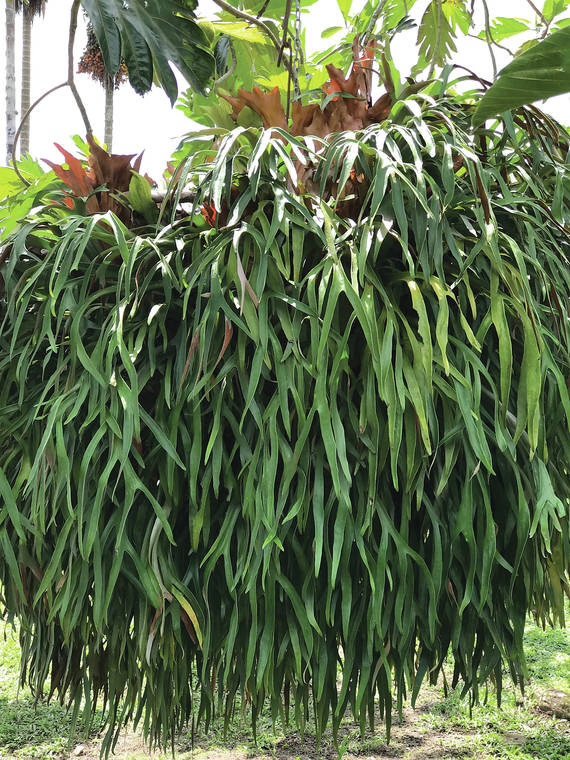Hawaiian gardens have long been famous for their vast array of orchids. We commonly see epiphytic types growing on hapu’u, tree branches and even rocky, soilless areas. In the last decade, other airplants like bromeliads have become popular because of their colorful foliage and flowers. Plants that do not need to be attached to the ground like these, receive moisture and nutrients from what is deposited on them.
The newest additions to the list of epiphytes for the small gardens are the staghorn or elkhorn ferns. A few species of staghorn or Platycerium have been grown here for years but are by no means considered common.
Of course, the Platycerium should not be confused with the false staghorn or ulu’he of Hawaiian forests. This is actually a climbing fern, Dicaranopteris linearis, that can grow into almost impenetrable thickets in the lowland rainforests.
The true staghorn ferns grow on trees mainly in tropical areas of the world. Staghorns come from Australia, New Guinea, Borneo, India, Africa, and Madagascar. Many come from tropical South East Asia. One species, Platycerium andinum, comes from Peru and Bolivia.
Although still plentiful in their native habitat, it has been only within the last few years that they have been grown by nurseries here, and some are still considered to be quite rare. Of all the species, the one most familiar to people is probably Platycerium bifurcatum, that is native to Australia. It has been reported that this species has yielded up to 50 cultivars, or hybrids.
The name Platycerium derives from a Greek word meaning broad horn. This describes the shape of the lower or fertile fronds, which actually resemble a set of stag’s antlers.
All staghorn species are members of the fern family. An interesting theory related to the genus Platycerium is that it is considered somewhat of a missing link in the evolution of ferns. When the fern spore is germinated, it first develops a flat, shieldlike structure called a gametophyte, or thalli. The true fern develops from this shieldlike structure and the thalli disappears. Because the Platycerium’s basal frond is virtually intact and plays an integral part in its growth habits, it is felt that this basal frond represents a transition between older and present-day forms.
A fossilized spore of Platycerium was identified in sandstone dating to the Cretaceous period, which supports various theories that this plant family has been around for millions of years, including the era of the dinosaurs. This denotes a heritage of great antiquity. Studies of the genus date back to the early 18th century, when these ferns were first identified in Africa.
Fossil images left in coal deposits 500 million years ago tell us that ferns were the first plants to evolve true leaves. Platyceriums have two distinct sets of leaves. The basal or fertile leaves adhere by root structures to their support. The fertile fronds project outward from a central apex in the basal frond. These fertile fronds can form a dramatic drooping effect, as with the Platycerium bufurcatum and Platycerium coronarium species, or they can be erect, as with Platycerium veitchii.
The fertile frond carries spores in splotches on the underside of the fronds and is a key in some species identification. Platycerium grande is distinguished from a similar cousin, Platycerium superbum, by being smaller. It also has two distinct spore patches on the underside of its fertile fronds, while Platycerium superbum has one large patch. As these fertile fronds grow and mature, they eventually yellow and fall off. The basal fronds play a different role in the plant’s overall function. As they mature, they turn brown and form a thick matting. This helps protect the stems and roots of the plant and also serves as a composting center for the debris that falls into the cavity created by the buildup of fronds. This provides food for growth for this type of epiphytic fern.
Although these spectacular ferns occur most often in tropical areas, many will survive prolonged dry seasons and are quite hardy.
The following species would not be recommended, however, for any cold weather below the 60 to 65 degree Fahrenheit range: Platycerium madagascariense, Platycerium ridleyi, Platycerium quadridichotomum, Platycerium wilhelminae-reginae. Those that tolerate a minimum of 40 degrees Fahrenheit include Platycerium stemaria, Platycerium vassei, Platycerium veitchii, and Platycerium willinckii. Those that can withstand colder growing conditions include Platycerium bifurcatum, Platycerium grande, Platycerium hillii, Platycerium superbum, and Platycerium holttumii.
Many cultivars have been developed and there is much speculation about whether any of these have occurred naturally, but the general theory among horticulturists is that they have simply escaped from cultivation and established themselves. This sounds especially feasible considering their antiquity and the interest these unusual plants have generated over the centuries.
Few insects or diseases bother staghorn ferns. Care is much the same as with other air plants. Avoid overwatering and feed occasionally with a complete liquid fertilizer according to directions on the label.



